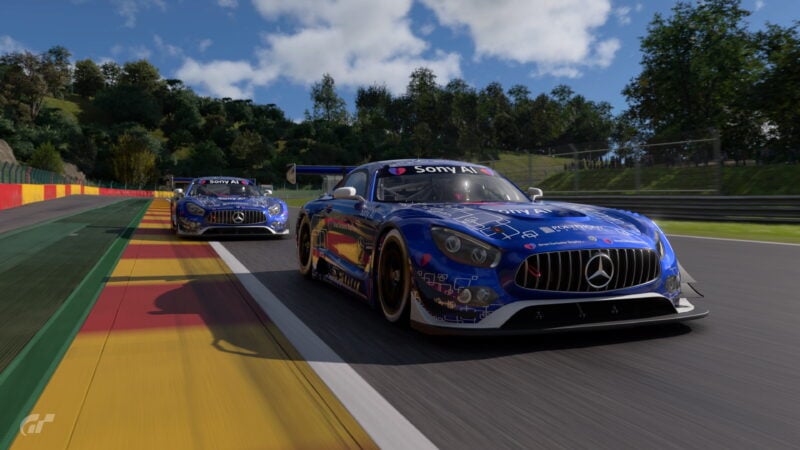
At the recent Gran Turismo World Series Finals in Monaco, I had the chance to be one of the first humans to race against Gran Turismo Sophy, the radical new artificial intelligence system developed by Polyphony Digital and Sony AI.
I expected to be trounced by the super-human driver (and I was!), but the way it defeated me changed my perspective on how important Sophy will be to the future of Gran Turismo and racing games in general.
Sophy is very, very different from other “artificial intelligence” systems you’ve seen in games before. Instead of following a simple set of pre-programmed rules, Sophy “learns” a car and track combination by quite literally driving it thousands of times. It also races with other cars on track, learning what “good” on-track behavior and race craft looks like. (If you want to learn more, check out my deep-dive on how Gran Turismo Sophy actually works.)
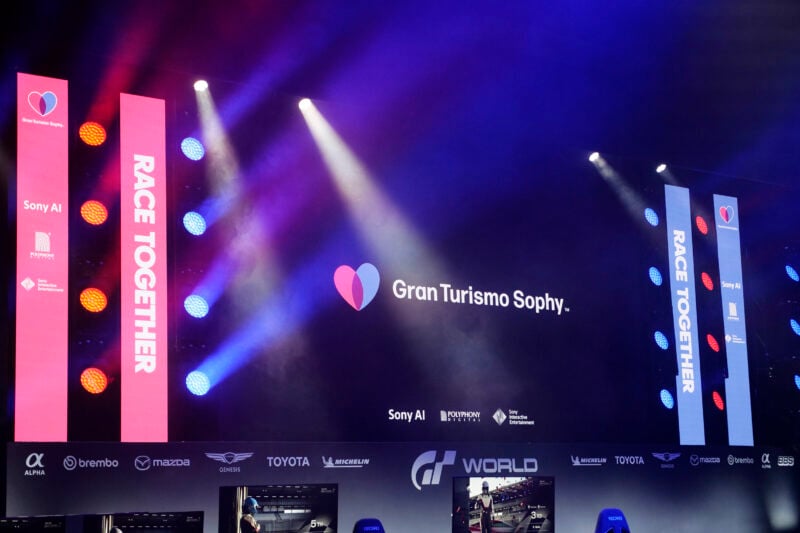
It is an impressive technical feat, but critics and average players have shared their confusion and indifference. Why should they get excited about a super-human driver? If it can defeat the likes of Igor Fraga and Takuma Miyazono, how could they ever hope to compete with it? How is that fun?
These are reasonable questions, and I felt my own sense of helpless intimidation when I got behind the wheel of my first race against Sophy at Spa Francorchamps in Gran Turismo 7. Despite the friendly name and little heart logo, I knew the car in my mirror was about to ruthlessly execute a set of instructions it had learned from thousands of laps around the circuit, with the single goal of defeating me. No pressure!
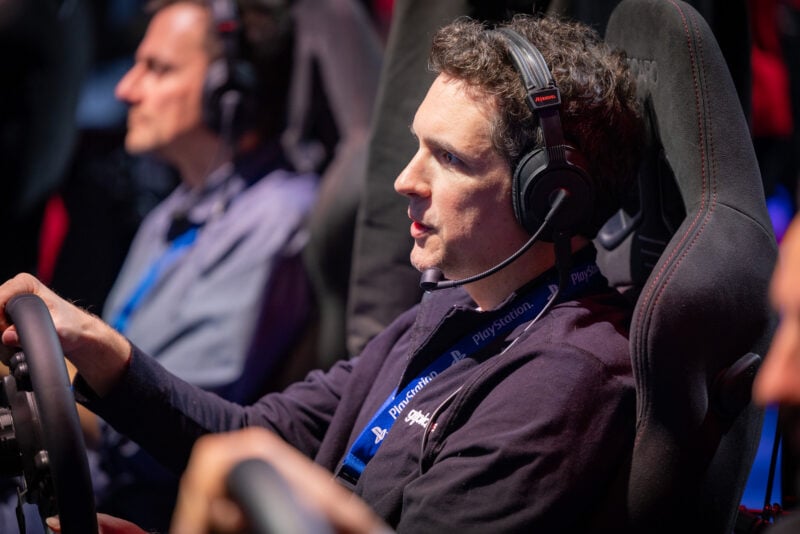
As we pulled away from the starting line in a pair of AMG GT3s, I was feeling anything but confident, and I expected that lack of confidence would translate into a missed braking point at La Source. I also expected Sophy would capitalize on the mistake with a dive-bomb to the inside, perhaps with a bit of contact. But… that’s not what happened.
Watching Sophy in the mirror, I could see it contemplating the move, then explicitly making the choice not to take it. It was a wise, human-like decision, as if it suddenly remembered the popular phrase “No race was ever won in the first corner, but many have been lost there,” from The Art of Racing in the Rain.

Sure enough, Sophy’s patience paid off. I nervously botched Raidillon and it passed me up the Kemmel straight. Although it clearly had more speed than I, it needlessly maintained a defensive line up the hill, sticking to the the right side of the track before darting over to the left at the entrance of Les Combs. This would be the only unnatural move I saw it make.
Somewhat relieved to be chasing Sophy now, I kept pace with it as well as I could. It was fascinating to drive behind and watch it work. Its lines and braking points revealed speed that would have taken me hours to find on my own. After the first lap, it finally started to pull away, but I was already starting to see the potential.
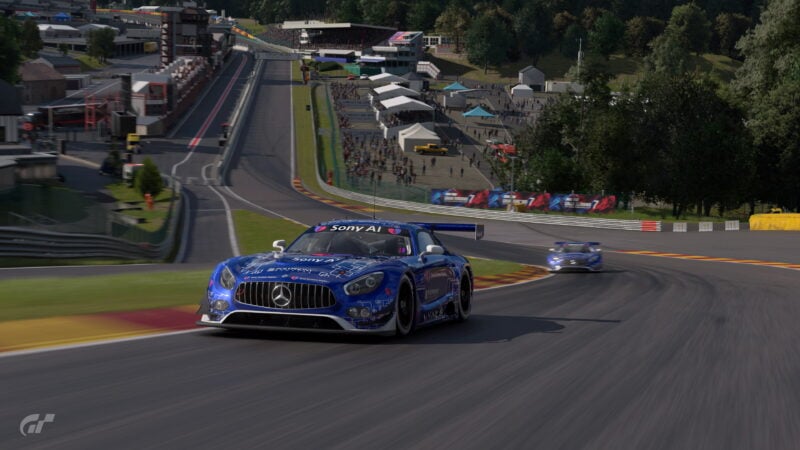
For our second race, I was feeling more comfortable with the car and track combination, and was able to hold Sophy off for much longer. I knew that Sophy was faster than me, but I had also learned Sophy drove with etiquette and restraint. Like a skilled and experienced human driver, I knew it would wait patiently for the right opportunity to pass me safely. What resulted was a wildly fun lap, as it pushed my defensive driving skills to the limit at every corner around the Belgian circuit.
When I did finally make a mistake and Sophy cruised by, I was not upset that I had lost the race — I was sad that our brilliant battle was over. It was the most fun I’d had playing Gran Turismo in a long time, especially against an AI opponent.
That’s when I realized what makes Sophy special for “regular” players like me. You might get lucky and have a similar battle in an online race, but the conditions and your opponents have to be just right. For the average player, that’s rare, and it’s even more rare for such a battle not to end in anger or frustration.
Sophy changes all of that. With the push of a button, you can keep racing against Sophy as much as you like. It’s a sparring partner that never gets tired, angry, upset, or bored. It’s simply there, all the time, to have fun with and to make you a better driver.

When GTPlanet first interviewed Kazunori Yamauchi after Sophy’s reveal, he described it as “a teacher” and “a friend to race with”. It sounded a bit far-fetched at the time, but now it makes more sense. There has perhaps never been a better teaching tool in a racing game.
The tight schedule of the World Finals and the Sony AI team meant that I had to step aside after my second race with Sophy, but I’m already hooked. I could have spent hours with the new AI, studying its replays and racing lines and perfecting my ability to defend each corner of Spa. It was a blast to drive with, and absolutely nothing like the tedious experience of racing against Gran Turismo 7’s current AI drivers.
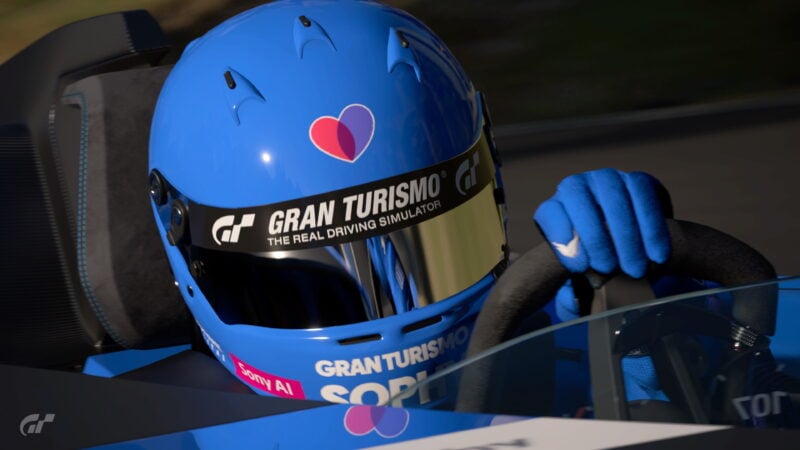
To be clear, Sophy still has a ways to go before its released to the public.
Although its driving model is already at a high level — it only made one odd move that I was able to see — its integration with GT7 is clearly still in development. My Sophy opponent was running on its own PlayStation 5 console and we were driving in a private LAN race. Nevertheless, the most difficult part of Sophy’s development appears to be behind the Sony AI team. Now they can work on refining the model and collaborating with Polyphony Digital to figure out how to best introduce it to Gran Turismo’s player base.
I have always been intrigued by Sophy, but I was never quite sure what to make of it. I think many in the community felt the same way. After this brief demo, however, the feature is now my most personally anticipated feature for GT7 and beyond. I cannot wait to see how this system continues to develop and evolve, and I cannot wait for my next opportunity to race against Sophy again.
See more articles on Gran Turismo Sophy and Sony AI.










